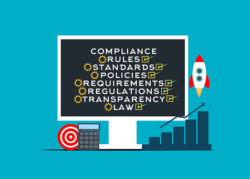What is a compliance check? It is a way to ensure that your business is meeting current, applicable regulatory and standards requirements.
This exercise usually forms part of a regular internal operational audit but may be conducted as a stand-alone exercise based on business needs.
Typically, as new regulatory requirements that may affect a business are set into law, it becomes necessary to conduct a compliance check. This will help see if there are new exposure gaps that the business must address.
Data privacy is a frontline issue for consumers and businesses alike these days, and GDPR compliance and legacy Enterprise Content Management is a top area of concern.

The Cost of Non-Compliance
The cost of non-compliance is more than twice that of compliance costs.
Therefore, businesses that continue to operate by “we’ve always done it this way” instead of continuously changing to meet new compliance requirements in a timely manner will pay a hefty price! They run at a risk!
Studies conducted by Ponemon Institute and Globalscape show that being compliant actually saves money.
Meeting regulatory compliance and standards requirements is a cost of business as the sole aim of these regulations is to ensure safety, and protect employee data, customer data and the environment.
These costs generally fall under three categories:
Regulatory penalties
A lot can happen between periodic business operational audits. It is important that gaps are continuously identified and addresses to ensure that the business does not begin to operate out of compliance between audits.
Compromised sensitive data – What is a Compliance Check?
Gain comprehensive visibility of your digital footprint so you can identify and remediate vulnerabilities before your customers’ personal and financial data can be compromised.
Lack of trust among customers and other external stakeholders
Effective cybersecurity that is maintained with up-to-date industry standards builds trust among customers, partners, and investors. Its absence, of course means that a business is untrustworthy about any claims around cybersecurity.
There is therefore an unwillingness to conduct further business with the company
To avoid these costs, it’s imperative that a company is proactive about compliance.
How to Continuously Meet Regulatory Compliance and Standards Requirements
To avoid compliance costs a company must be proactive about compliance. There are 4 ways this can be done in small businesses
1.Consistently Remain Current on Emerging Regulatory Changes
Being proactive about checking for updated standards and regulations. This is further justification for a Compliance Champion in the business.
2. Ensure Compliance is Understood by Everyone in the Business
Compliance is not the responsibility of a handful of people in the company.

Everyone must understand the regulations and standards applicable to their function and the consequences of non-compliance to them and to the business.
Most companies offer training to address this critical element of their compliance program.
3. Designate a Compliance Champion
While compliance is part of everyone’s job function, there should be only one central person who owns compliance.
Most large organizations have a compliance officer or entire compliance teams. The majority of small or mid-sized businesses usually do not have the resources for this.
Nevertheless, it is wise to designate someone to handle compliance issues as part of their role and responsibilities.
This should include monitoring compliance, checking for updates to regulations and standards, and informing the rest of the business.
Who can fill this Role?
Some companies use the Quality Manager or Operations Manager to fill this role.
Larger companies may also involve the legal department in this exercise
4. Monitor for Compliance with the Right Tools – What is a Compliance Checklist?
It is no longer sufficient to use static tools like checklists to monitor for compliance because these only represent a snapshot.
They only show there is compliance when the checklist is being completed.
Note that some areas of business may still require the use of checklist because automation may not be possible in those areas.
Automated tools :
- Save time
- Allow the monitoring of compliance in real-time, providing assurance that the business is compliant with regulations and standards,
- Minimize data breaches caused by employees
- Minimize human error
Conclusion
Most businesses need to better understand what is a compliance check and its use to help them address regulatory and standards requirements gaps that need to be addressed.
Contact Us to Assess Your Compliance Program Now
References
The true cost of compliance with Data Protection Regulations https://www.globalscape.com/resources/whitepapers/data-protection-regulations-study

